I have so much to tell, I really don’t know where to begin. Should I write about the IDF’s daring and heroic rescue of two of the Israeli hostages held in Gaza, last month? The deadly terrorist shooting attack the Thursday before last at the entrance to Jerusalem from Ma’aleh Adumim? The even more deadly terrorist attack the previous Friday at the Re’em Junction in the south of Israel? Or the one that took place at the gas station near the town of Eli even as I was writing this post, which I began last week? The terrorist in that last attack, by the way, turned out to be a Palestinian Authority police officer!!!
Or should I confine myself to happier news, such as my choir’s successful concert the week before last? My field trip to Masada last week? The municipal and local authority elections the following day, held in the shadow of the war? The last is perhaps not such a happy topic, after all, as one is forced to remember those who cannot vote because they have been refugees from their homes in both the south and the north of Israel since October last year. And one remembers also those who would have been candidates themselves, had they not been murdered on October 7th. People like Ofir Libstein, head of the Sha’ar Hanegev Regional Council, who died in defence of Kibbutz Kfar Azza, together with his 19-year-old son, Nitzan, his 81-year-old mother-in-law Bilha and his wife’s nephew, 22-year-old Netta.
Perhaps it would be best if I just begin with the concert and see where time and my own inclination takes me. It will no doubt be a spur of the moment decision…
On Tuesday, February 2oth, the Jerusalem Oratorio Chamber Choir, under the direction of our new conductor, Assaf Benraf, gave a concert at the Becker Auditorium in the Center for Brain Sciences at the Givat Ram Campus of the Hebrew University. The theme was Exile and Longing – a programme chosen in the summer, long before the events of October 7th which made it all the more poignant. It was a varied programme, the music – ranging from Verdi classics such as the Chorus of the Hebrew Slaves from the opera Nabucco (how could it not?) and the Chorus of Scottish Refugees from Macbeth, through Salomone Rossi’s early Baroque setting of Psalm 137 (“By the rivers of Babylon”), the over-the-top German Romanticism of Schumann’s “Am Bodensee“, an early Hebrew classic “Tzion Tamati” by Dolizki, Part 1 of Castelnuovo-Tedesco’s song cycle based on Garcia Lorca’s Romancero Gitano, Eisler’s setting of Brecht’s Letter to a German Soldier at Stalingrad, to popular standards such as “Mayn Shtetele Belz” and “Douce France” – punctuated by poetry readings in many languages, including Arabic, and by a rendition of Tarrega’s “Recuerdos d’Alhambra by guitarist Itay Bainer. I have no recordings of the more classical pieces, but here are some of the lighter, more popular pieces from the second half of the concert.
Here, for starters, is the piece by Castelnuovo-Tedesco:
The guitarist, Itay Bainer, accompanied us also in this Neapolitan stalwart, cherished in the hearts of so many Italian immigrants to the New World:
In the late 19th – early 20th century, in the absence of a state of our own (a tragedy now, thankfully, rectified with the establishment of the State of Israel), Jews fleeing the pogroms, discrimination and poverty of eastern Europe, sought refuge in the United States, where they continued to long for the family and friends left behind in “the Old Country”. One of the most popular Yiddish songs, reflecting this longing, was “Mayn Shtetele Belz”, written for Alexander Olshanetski’s play The Song of the Ghetto. It is said that in the Vilna Ghetto, the Nazis used to force the Jews to sing for them, echoing the lament of the exiles in Babylon:
“For there they that led us captive asked of us words of song, and our tormentors asked of us mirth:
‘Sing us one of the songs of Zion.’”
One of the Jews’ favourite songs was this one:
In 1943, in German-occupied France, Charles Trenet and his pianist, Léo Chauliac, created the song Douce France, a love song to the France of Trenet’s childhood.
We finished with the African-American spiritual Deep River, which expresses a universal longing for an idealised land beyond the River Jordan, symbolising Heaven – that final Home to which we all hope to go, one day:
The concert was a great success and will receive a second airing in April.
********
In my previous post, I described a field trip to Caesarea, under the auspices of Yad Ben Zvi, in the framework of a course on the archaeology of the Second Temple period. Last week, I participated in another field trip in the same framework, this time to Masada.
Masada, where 960 Jews under the command of Elazar Ben Yair committed suicide rather than submit to the Romans, holds an iconic place in Jewish and Israeli history. For many years, inductees to the IDF’s Armoured Corps were sworn in at Masada. Every Israeli schoolboy and girl would visit there at least once on a school trip. It was on the itinerary of every youth movement’s annual trip, of every tourist, every VIP visitor to Israel. I myself have visited there several times – although it has been many years now since I was last there.
The weather favoured us. Monday dawned bright and sunny as we left Jerusalem and headed east, towards the Dead Sea. We stopped for breakfast at Ein Gedi and then headed south. We had started early, at 8:15 am, but it was past 11 am by the time we reached Masada. The plan was to ascend the plateau by cable car, tour the site for about 5 hours and then make our descent via the Snake Path, which, said our guide, Efrat, would take about an hour and was not compulsory. Anyone who wished to could return by cable car.
The cable car station is on the eastern side of the plateau, more or less facing the Dead Sea. From the cable car, one gets a clear and awe-inspiring view of the surrounding desert, including at least two of the sites of the Roman camps with which Flavius Silva, the commander of the besieging Roman troups, surrounded the rebels’ stronghold.
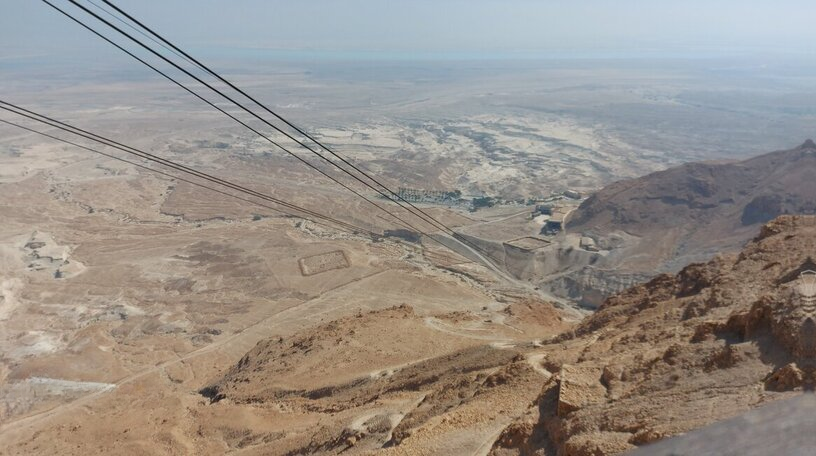

There are at least two Herodian palaces on top of the plateau of Masada. Most of the building on Masada can be attributed to Herod, the great builder, although Josephus tells us that the first person to fortify Masada was the Hasmonean High Priest, Jonathan (Yonatan). Most experts assume this meant Alexander Yannai, the Hasmonean king and high priest (103 – 76 BCE) , whose coins have been found at the site. There are a few, however, who believe the reference is to Jonathan the High Priest, brother of Judah the Maccabee. At all events, no irrefutably Hasmonean remains have been discovered at Masada, except for the coins – and coins, of course, can remain in circulation for many years after they were minted.
We first visited the Western Palace. As Efrat is always reminding us, visiting an archaeological site always requires a great deal of imagination. One sees two or three courses of stones, partially plastered and painted, and one has to imagine, from comparison with more fully-preserved sites, and from the descriptions of historians, such as Josephus, the height of the walls, the decorated frescoes, who would have used the room and for what purpose.
This, then, was apparently the entrance hall of the Western Palace:
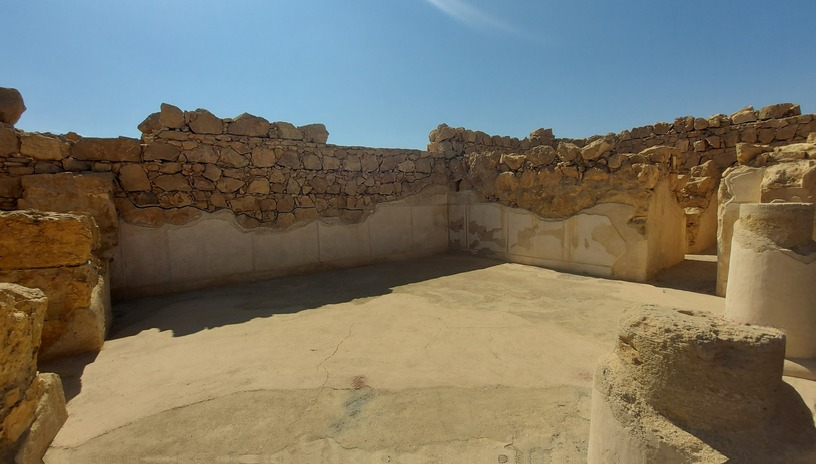
Of course, we must recall that the stuccoed walls would have been painted, either to resemble marble – which was exceedingly expensive – or with brightly-coloured designs.
Nearby is a staircase leading to the second floor, where there is a bathing complex – almost a spa – with mosaic floors, stuccoed walls, baths and bathing pools as well as what may have been a guest suite.
Herod might not have spent much time here, but his Roman patrons might have chosen any time to pay a call, and everything had to be ready for high-ranking visitors!

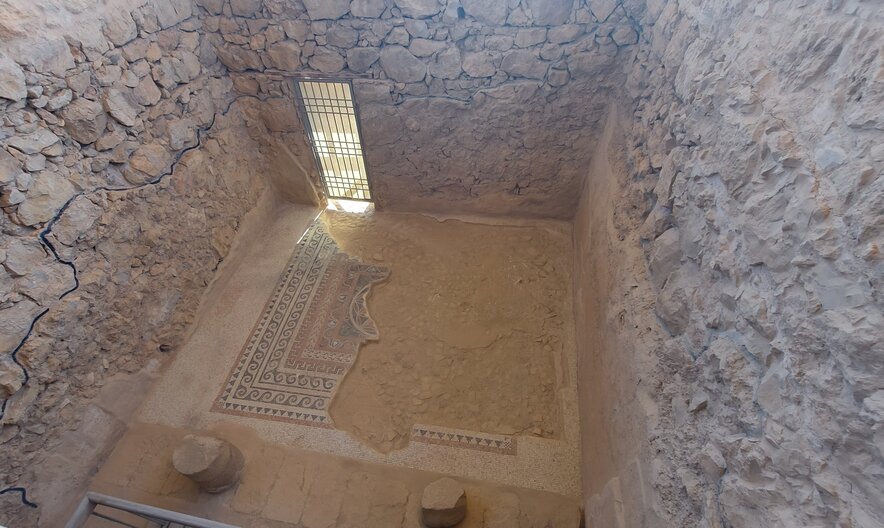

There is also a public bath house complex, built like a typical Roman bath house. As we know – and as I have mentioned in previous posts – the public bath house was an important part of civic life for the Romans, and Herod brought the idea to Judaea. The bath house was a meeting place, a place for exercising, and conducting business. The public bath house complex at Masada is entered via a mosaic-covered courtyard, or palaestra, which would be used for exercising. There was then a service room, where one could leave one’s clothes before entering.
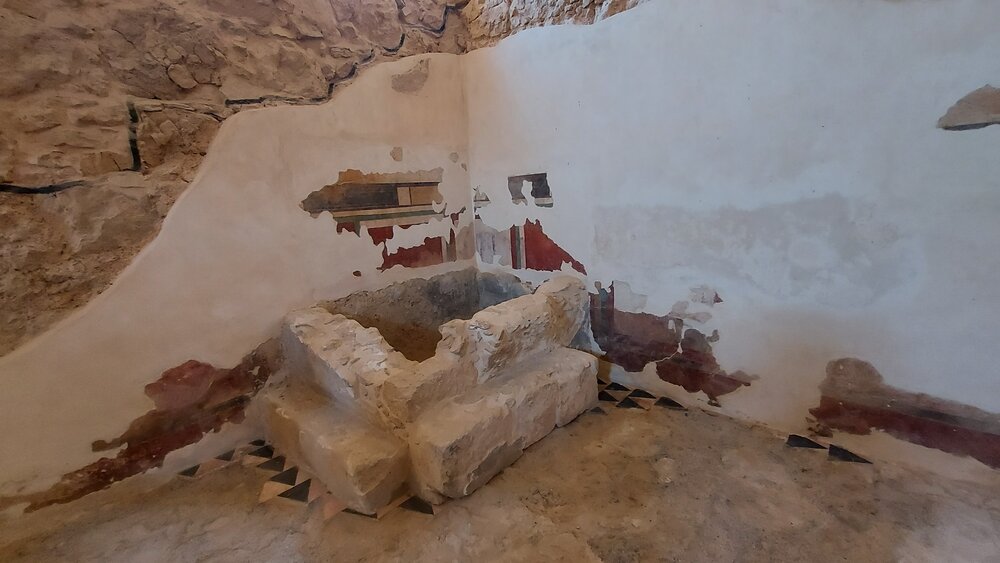
Bath house patrons could enjoy a variety of facilities. There would be a hot room (caldarium), heated by a hypocaust, a cooler room or tepidarium and finally, one could take a bracing plunge in the cold water pool of the frigidarium.
The hypocaust at Masada has been partially reconstructed so as to allow visitors to see how it worked.

The caldarium would have a double floor. The upper floor would be separated from the lower by small pillars (seen above). In a side room, a furnace would be stoked, from which hot air would be circulated by pipes under the floor and through the walls. The pipes would not, of course, be visible to the bath house patrons, as they would be hidden, as you can see in the picture below, between the inner and outer walls of the caldarium. Patrons would have worn wooden shoes or sandals to protect their feet from the hot floor.

Herod, as I have already mentioned, had more than one palace at Masada. The Western Palace is the largest in area, but the most famous is the three story Northern Palace. This is the one visitors first espy from afar when approaching Masada. Architecturally, it is one of Herod’s most ambitious and daring projects, built, as it is, on three levels of rock at the very edge of the abyss, and making considerable use of awe-inspiring support walls. This palace was where Herod would retire to enjoy solitude, as well as an unparalleled view over the desert to the Dead Sea from the semi-circular terrace.
It is believed that the king and his family resided in the Upper Story, while the two lower floors were where he received guests. From the top floor, the king had a birds’ eye view, not only of the magnificent panorama, but also of the lower terraces – and, since the palace faced north, he would also be able to enjoy the shade and the cooling afternoon breezes that tempered the desert heat.

To reach the lower terraces, the king would have descended a winding staircase, possibly hewn in the rock. On the Middle Terrace there was a circular reception hall, of which all that remains today are the foundations, partly rock-hewn and partly built. There was also what appears to have been a library.

It is the Lower Terrace which is the best preserved. Here, a large reception room/banqueting hall was excavated. Surrounded by colonnades, some of the stucco-coated pillars survived to their full height, with their Corinthian-style capitals almost intact. As you can see, the columns were partly freestanding and partly carved into the rock. Two gilded capitals were unearthed. The walls and pillars, with their elaborately decorative capitals, were originally painted. In some cases, the painting was intended to deceive the eye into believing the walls were covered with marble.
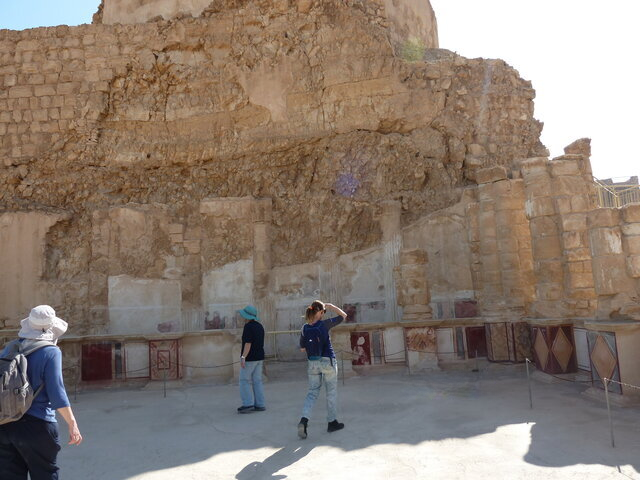
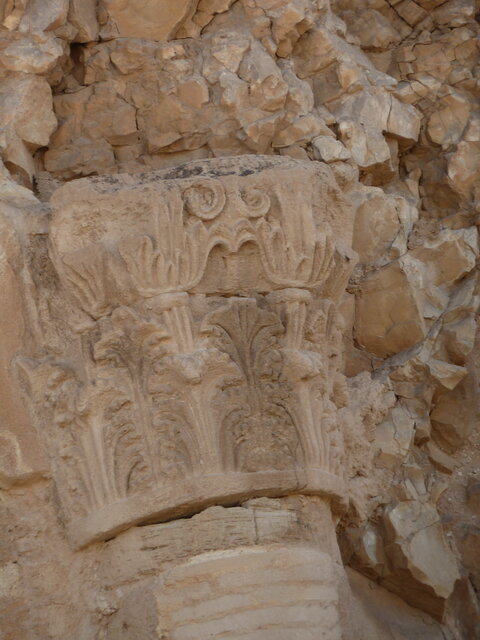
Of course, you must be wondering how Masada, situated in the middle of the desert, was supplied with water. Herod had an impressive water supply system constructed, including dams which diverted floodwater from the flash floods which occasionally occur in the wilderness to man-made canals. These canals filled 12 huge water cisterns quarried on two levels of the plateau.
And, of course, there were huge store-rooms – which were left with all their contents by the Zealots defending Masada, so that the Romans could see that it was not a lack of supplies which had led them to take their own lives, rather than surrender.
Masada was one of Herod’s many palaces, but the site is best known as the last stand of the Zealots, Jewish rebels against the Roman invaders, in 73 CE. We visited the site of the synagogue – originally constructed in the time of Herod (who died in 4 BCE) as a stable.

During the Revolt (66 – 73CE), it was converted by the Jewish rebels who had taken refuge at Masada, into a synagogue. They added benches around the hall and erected a small corner room, with two small holes in the floor, perhaps for use as a Genizah. At all events, scroll fragments were discovered there, including the chapter of Ezekiel containing the Vision of the Dried Bones. Can you imagine the feelings of the archaeologists upon unearthing such a find, in such a place? Because there were bones unearthed at Masada – which were later given a military burial by the Chief Rabbi of the Israel Defence Forces. There have been some dissenting voices in the archaeological community relating to the identity of these remains – but in 1963, in the young Jewish state, the majority had no doubt of the appropriateness of the interment of those who were possibly the last defenders of Jewish independence for two thousand years, with full military honours, by the Chief Rabbi of the defence forces of the newly-reborn State of Israel.
The heroes of Masada were buried at the foot of the Roman siege ramp, opposite the very place where the wall was breached.

The mound with the winding white path, about one third of the way down the photo, marks the place of their burial.
This, as I said, was the place where the defence wall was breached by Silva’s legionaries. The defenders shored it up with a wooden wall. The Romans shot flaming arrows into the wood, but the wind blew the flames back onto the Romans. Of course, the defenders saw this as a sign of divine intervention – but then the wind changed and began to devour the wall. The Romans did not fight at night and, knowing there was no way for the defenders to escape, returned to camp until the next morning. But the rebels preferred death to slavery. Josephus tells us that after each man had killed his wife and family, they drew lots to decide who would kill his remaining comrades and who would be the last man standing, who would have to fall on his own sword. Of course, Josephus was not present himself and claimed to have received his information from two women survivors, who had hidden, together with five children, in a water conduit and thus survived the mass suicide. Be that as it may, when the Romans entered the site the following morning, they met no resistance. There were only dead bodies.
There is much, much more to see on Masada – and we did see more, but not nearly the whole. We had planned to descend via the Snake Path, but at about 2:30 pm, the site’s Public Address System warned us that the Snake Path would be closed at 3 pm, and we still hadn’t seen many of the things we had planned to see, so we decided to forgo the long walk down the winding footpath and return as we had come, by cable car. I have to admit – I was not all that disappointed 😉
So we were able to see a few more things, but not all that much, since in winter, the last cable car descends at 4pm and the site closes. In fact, Efrat, our guide, had not been warned in advance that the Snake Path would close an hour earlier. A lot of things have changed (not always with advance notice) “because of the War”. It isn’t surprising, really. Many of our archaeological sites (and certainly our national parks) do not have “Safe Spaces” and nobody wants to be exposed on the side of a mountain in the case of a missile attack – so many places still remain closed, or their opening hours are severely curtailed. Indeed, at least twice while we were on top of the plateau, jet fighters roared overhead – a reminder, as if one was needed, that our country is at war.
In the years following the excavation of Masada, the slogan “Masada will not fall again” was coined. Since October 7th, many of us feel our very existence as a state is threatened, and that slogan is more than ever apposite.
I had a lot more that I wanted to write, but I think this post is too long already. If you are still with me, I thank you for your forbearance. Next week, I have another field trip, in which we shall meet Josephus again, and possibly understand more of what was going through his head when he described the heroism of the defenders of Masada, in the light of his own personal history. If you have enjoyed this virtual tour, I hope you will join me again soon for more of the wonders of Israel’s history and landscape.

I have enjoyed it very much and I will be right here for any and all others that you are able to present. And I thank you for those you have already written. I am very interested. And I have learned a lot!
I will say I enjoyed the concerts too. Thank you so much! I really like when you include those. That guitarist is a marvel I will add. I play the guitar since I was elecven years old. I could never attain such excellence as he.
I am glad you liked it. Do you still play the guitar? Have you any recordings? I started learning classical guitar in my last year at school, but didn’t keep it up, alas.
I do. I started when I was 11. I had instruction for a year or so…learned to read music at that time and played from books as all beginners do. I have good pitch and I can play by ear, hence I played a lot. Having children made it harder after having come back from our several years of not being in our own Country.
I used to have recordings— but when I was still married, we were all over Europe and the near East. My father had charge of everything from our former home that I and husband had, in his attic. Many things got ruined by intense heat over a period of time including some damage to my guitar. A relatively expensive one.
Lovely music! And ditto to what Carole said.
I enjoyed your pictures and descriptions of Masada.
Praying, as always for you, your family and your country.
Thank you. We are now working on our second programme of the season, together with one of our “sister choirs” – the Saint Saens Requiem. Something completely different.
That is a beautiful work. I heard a recording some months ago.
I am glad to hear you are doing your singing during these terrible times. I do appreciate you sharing the bad and evil news as much as I truly enjoy the good and beautiful. Thank you and I pray for your safety.
Thank you. The bad news continues, though it could be worse. Today, a 14-year-old “Palestinian” terrorist tried to murder a 64-year-old Jew by stabbing him in the back, here in Jerusalem. Fortunately, the wound was not fatal and the murderous little punk was arrested. You probably won’t hear about this in the media but if the terrorist had succeeded in his aim and been shot dead by security forces, no doubt the media would have been headlining it: PALESTINIAN CHILD SHOT DEAD BY ISRAELI SECURITY FORCES.
I stayed with you to the end.
The music was beautiful, thank you for including it.
You are an excellent virtual tour guide, and I appreciate it.
No matter what, I am praying for the peace of Jerusalem.
I am glad you enjoyed the tour. I love sharing the sights and sounds that I love with my friends.
Though I have visited Israel, this is a site with which I am totally unfamiliar. Thank you for the photos and telling us about it. Janet
I am really surprised that you never visited Masada as it’s one of the “must see” tourist sites. When were you here? Obviously, it’s time for another visit 🙂